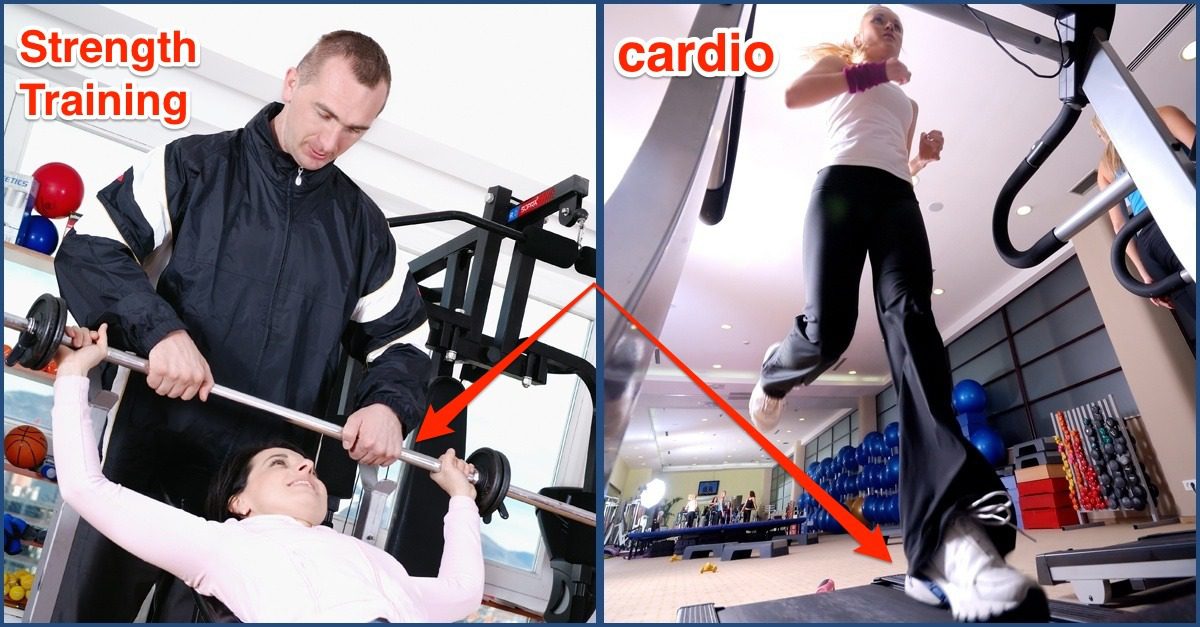This article will show that the benefits of doing steady-state cardio for fat-loss (without muscle loss) are often misunderstood and overstated. Then it will offer a solid, commonsense argument for metabolic strength training concepts, which are safer, more enjoyable, and much more effective training option for helping your clients build the lean and muscular body that they want.
Research Confusion
A 2012 study published in the Journal of Applied Physiology looked at the effects of aerobic and/or resistance training on body mass and fat mass in overweight or obese adults. It concluded that, "A program of combined Aerobic Training and Resistance Training did not result in significantly more fat mass or body mass reductions over Aerobic Training alone" (1).
Naturally, these results made the rounds in the media, attached with the claim that "cardio is better for fat loss than weight-training." But the reason cardio works faster than weight training in these short term studies isn't because it has special fat burning powers over strength training, it's simply because cardio burns more calories during the workout than strength training.
And the relationship of how many calories you consume per day to the number you burn per day is the single most important factor when it comes to determining whether you lose fat.
As an aside, the idea that you need to be in a caloric deficit to lose fat isn't personal opinion, nor is it up for debate by so-called diet gurus. In other words, it's not about what this or that person says about nutrition -- it's about what the evidence shows.
The research into the potential advantages of diets emphasizing protein, fat, or carbohydrates have found that reduced-calorie diets result in clinically meaningful fat loss, regardless of which macronutrients they emphasize. (2)
Now, this isn't to discount that some calories are more nutrient dense than others -- we've all heard the term empty calories -- but one can still be well-nourished and overfed. So as important as it is to eat high quality, nutrient-dense foods, you can still gain fat from eating "healthy," if they eat too many calories relative to what they're burning.
So when it comes to doing cardio, fat loss comes from burning more calories than you consume. It's obvious why cardio works faster than weight training in these short term studies comparing cardio training to weight training for fat loss -- because cardio burns more calories during the workout than strength training.
However, instead of spending the extra time doing cardio to burn (let's say) 300 calories, you can simply cut 300 calories out of your diet each day and end up with the same result without having to bother with all the potential side effects and boredom issues with cardio.
This is why cardio training isn't emphasized in my book, Strength Training for Fat Loss. In most cases, you eliminate the need for it (from a fat loss perspective) when you simply eat fewer calories to create a deficit.
In other words, you essentially eliminate the need for doing cardio (from a fat loss perspective) when you simply eat fewer calories to create a deficit.
The Negative Side Effects with Cardio
The problems with steady-state cardio for long-term fat loss are the negative side effects of the two most common cardio training methods, jogging and cycling. Both training modalities are effective forms of exercise and are nice ways to get outside and do something active, but there are major drawbacks to doing them regularly.
Both jogging and running (jogging is a slower run with a shorter stride) can be tough on the joints (even with proper strength training) because each step you take brings an impact force of about two to three times your body-weight. The impact force results from an abrupt decrease in velocity of the foot as it contracts the ground. In a 30-minute run, a typical runner will have about 5,000 impacts, so the accumulation of them are likely the root of the injury problem.
The impact force and the ensuing impulse wave have been identified as potential factors in injuries such as stress fractures, shin splints, cartilage breakdown, low back pain, and osteoarthritis (3).
Furthermore, most of us sit too much during the day. At work many of us sit at a desk, and at home we sit while using the computer and watching TV. It's no secret that sitting (i.e., being sedentary) isn't the best thing for functional capacity (our movement ability and athleticism), but physical activity is great for helping us get lean and increase strength and performance.
Although cycling is physical activity, it's done from a prolonged sitting position where you're hunched over the bike. So you're not only sitting all day at work and at home, but when you work out, you're sitting again! Furthermore, cycling gets your body better at cycling -- it doesn't do much for strengthening your muscles for day-to-day activities.
This isn't meant to convince you to quit running or cycling, especially if you enjoy these activities. It's simply to inform you of their limitations and risks.
The workout programs in my book, Strength Training for Fat Loss provide a tremendous metabolic training effect without the impact on your joints that comes from running or jogging. In addition, the workout protocols are designed to fight the negative effects of sitting by training your muscles in more athletic postures and more dynamic movements.
The Verdict Is In: Strength Training + Diet = Fat Loss Without Muscle Loss
Although any type of physical activity can have positive health benefits, the benefits of steady state cardio from a fat loss (without muscle loss) perspective is often misunderstood. Research like the type mentioned above only adds to the confusion.
The facts are:
1) You don't need to bother with all that boring cardio (to burn calories) when you simple eat less calories to create a deficit
2) You don't just want a "lean" physique -- you want a lean, strong and athletic-looking physique. To achieve the "strong and muscular" part, you've got to do resistance training, which is why the researchers of these studies usually say that a program including resistance training is needed for increasing lean muscle.
There's weight loss and there's fat loss. When people say they want to lose weight, they mean they want to lose fat, because you certainly don't want to lose muscle as muscle creates the shape of your body. So when women talk about "toning," "enhancing," or "shaping" certain areas of their body, what they're really talking about is muscle, as you can't build a perkier, rounder, or sexier anything without building muscle.
In short, if you're looking to lose fat, go with metabolic strength training concepts as your primary form of exercise. Watch your diet (instead of doing lots of cardio) to reveal your shape, and strength train to improve that shape.
References:
1. Willis et al. Effects of aerobic and/or resistance training on body mass and fat mass in overweight or obese adults. J App Phys., vol. 113 no. 12: 1831-1837; 2012.
2. Frank M. Sacks, M.D., George A. Bray, M.D., et al. Comparison of Weight-Loss Diets with Different Compositions of Fat, Protein, and Carbohydrates. N Engl J Med 2009; 360:859-873February 26, 2009
3. Yingling VR, Yack HJ, and White SC. 1996. The Effect of Rearfoot Motion on Attenuation of the Impulse Wave at Impact During Running. Journal of Applied Biomechanics. (Champaign, IL: Human Kinetics), 12, 313-325.










